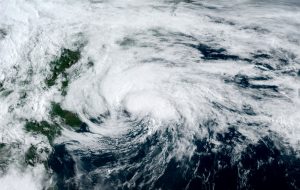
The peak of hurricane activity in the tropical waters south and southeast of the United States is typically in early to mid-September.
But hurricanes can occur any month of the year; the calendar isn’t the important thing — the ocean temperatures and the lack of wind shear are.
Hurricanes are large, whirling storms that obtain their energy from warm ocean waters and originate in the Atlantic basin, which includes the Atlantic Ocean, Caribbean Sea, Gulf of Mexico, and the eastern North Pacific Ocean.
All tropical storms form over warm waters. The evaporation of the warm ocean waters condenses to form clouds and precipitation releasing latent heat energy that helps to maintain the storm.
In general, hurricanes will not form unless the water temperature is at least 80 degrees.
Hurricane season carefully follows the seasonal cycle of ocean temperature. The Atlantic hurricane season officially starts June 1 and lasts until Nov. 30, which is the period when about 97% of hurricanes occur.
Hurricane Alex was declared a hurricane on Jan. 14, 2016, and maintained hurricane-force winds until Jan. 15. The Northern Atlantic Ocean is typically not 80 degrees in January.
Alex formed over waters whose temperatures were about 68 degrees, far below the norm. But the air high above was very cold, at minus 76 degrees. The 144-degree difference between the air and water temperature led to strong evaporation, helping to give the storm enough energy to become a hurricane.
An average hurricane season produces 12 named storms, of which six become hurricanes, including three major hurricanes.
An above-normal Atlantic hurricane season is expected this year. The 2020 seasonal forecast expects 13 to 19 named storms (winds of 39 mph or higher), of which six to 10 could become hurricanes (winds of 74 mph or higher), including three to six major hurricanes (with winds of 111 mph or higher).
The first hurricane of the 2020 season, Hurricane Arthur, took place May 16-19.

